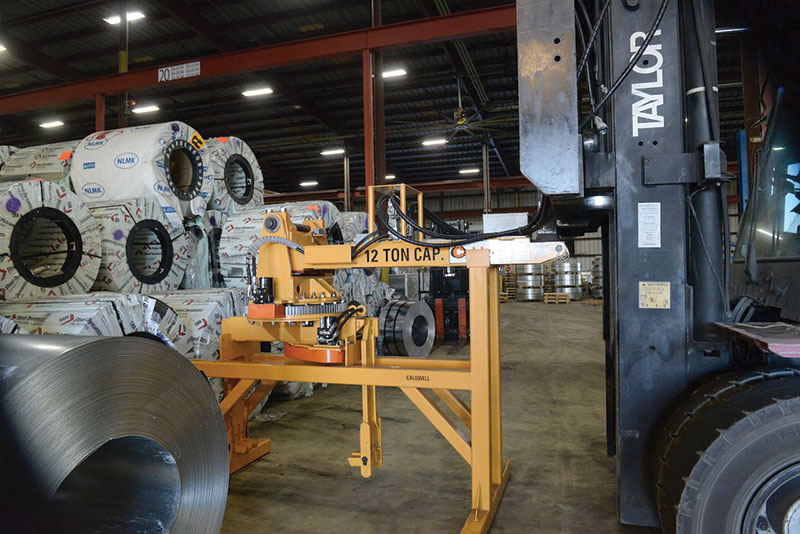Custom forklift attachment adds safety and productivity at stamping plant
An hour-long, three-person job is now completed by one forklift driver in 20 minutes.

When MiTek USA’s stamping plant in Tampa, Fla., started taking delivery of longer trains from domestic steel suppliers, the increased throughput challenged the company’s receiving processes. After purchasing a custom forklift attachment, the company significantly improved speed and safety.
Previously, MiTek was using its 35,000-pound capacity lift truck (Taylor) with a wire rope sling strapped over the center of 6-foot-long forks. An employee then manually passed the sling through the eye of the coil and attached it with a swivel hook to complete the connection.
“I put myself in the rail car to experience it from the rigger’s viewpoint, and it wasn’t satisfactory,” says Ken Jurgensmeyer, director of manufacturing operations at the facility. “We often had to lift at an angle because of how far away we had to position the forklift. Once we picked the coil, it was taken to the loading dock and awkwardly swung into position so a second lift truck could move it onward.”
The coils can shift during transit and end up being very close to each other. For the attachment grabber to fit, the lifting shoes pivot and the legs are very thin. The new attachment (Caldwell Group) is known onsite as the master coil lifter. It replaced the previous method that involved three personnel, including one precariously positioned on the rail car truck.
In a proactive effort to prevent injury, Jurgensmeyer sought a custom system to eliminate manual rigging. As a byproduct, the attachment also sped up production considerably. With a capacity of 24,000 pounds, the attachment reduced the time it takes to unload a single car from one hour to 20 minutes and, more importantly, having a rigger beneath the hook and forks is no longer a requirement.
MiTek receives the steel coils in batches of six or seven aboard each of a half dozen rail cars. Using the previous method, it would have taken all day to unload a whole train, which can now be completed in a fraction of the time with fewer people. Even the transfer to the second lift truck is improved because operators can lower the coils onto a frame for easy pickup.
Jurgensmeyer said the coil lifter is required to lift 110,000,000 pounds of steel per year, or about 94 coils per week. Currently, 100% of the steel at the Tampa facility is from domestic suppliers, placing further demand on a quick turnaround of rail cars.
Following its successful implementation at the Tampa plant, another site in Phoenix, Ariz., has also adopted the solution, where it again enhanced safety and efficiency versus previous methods

Article Topics
Overhead Handling News & Resources
Monorail Manufacturers Association celebrates 90 years of monorail best practices Are Your Crane Operations Stuck in the Past? Demag demonstrates DCBS Electric Balancer and other light lifting capabilities Report: Global crane and hoist market to see 5.22% CAGR over 2020-2027 CMAA announces updates for two specifications Overhead lifting safety webinar series set for September Are exoskeletons the X factor for industrial workers? More Overhead HandlingLatest in Materials Handling
Beckhoff USA opens new office in Austin, Texas Manhattan Associates selects TeamViewer as partner for warehouse vision picking ASME Foundation wins grant for technical workforce development The (Not So) Secret Weapons: How Key Cabinets and Asset Management Lockers Are Changing Supply Chain Operations MODEX C-Suite Interview with Harold Vanasse: The perfect blend of automation and sustainability Consultant and industry leader John M. Hill passes on at age 86 Registration open for Pack Expo International 2024 More Materials HandlingAbout the Author
Subscribe to Materials Handling Magazine

Find out what the world's most innovative companies are doing to improve productivity in their plants and distribution centers.
Start your FREE subscription today.
April 2024 Modern Materials Handling

Latest Resources










